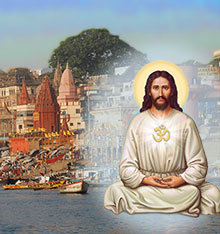 This post is the fourth and final of a series where we present our view of dharma, which we view as the teachings of the dharma which Jesus brought back from India.
This post is the fourth and final of a series where we present our view of dharma, which we view as the teachings of the dharma which Jesus brought back from India.
Dharma is Eternal
The principles of dharma, like the principles of mathematics, are both eternal and universal in their application.
Just as mathematics has no originator or author or connotation of any culture, the same is true of dharma. Dharma is discovered, not created by human beings. For example, “Euclidian Geometry” was discovered by the Greek Euclid, but it is not Greek in any way and carries no connotation of Hellenism.
Nevertheless, it cannot be responsibly denied that Sanatana Dharma, Eternal Truth or Religion, has been completely and perfectly imparted to us by the enlightened sages or rishis (seers) of India, many of whom are completely unknown to us by name. Their vision has been conveyed to us in various sacred texts, using Sanskrit as the perfect, exact and necessary vehicle for its expression.
No one should presume the ability or the authority to declare which texts are or are not of supreme or exclusive authority, but we can feel secure in considering that the Vedas, Upanishads, Bhagavad Gita, and the sutras on which the six orthodox Darshanas (Nyaya, Vaisheshika, Purva Mimamsa, Uttara Mimamsa or Vedanta, Sankhya, and Yoga) are based can be accepted as trustworthy guides.
In addition there are numberless texts that transmit Sanatana Dharma to the seeker. These include the writings of great philosophers and yogis, ancient and modern. But the ones listed are of unquestioned reliability.
Dharma is universal
Wherever in the world we find any truth, philosophical or spiritual, it is a reflection of Sanatana Dharma, and is often evidence of a forgotten historical presence of India’s influence in that part of the world. At the root of every valid religion we will find Sanatana Dharma–not just abstractly but as the historical presence just mentioned. For example, both Buddha and Jesus were nourished in the bosom of Sanatana Dharma–one as a “native son” and the other as a pilgrim seeker.
Those who consider themselves their followers may have strayed far from the principles which produced and empowered those two great teachers, but that in no way dims their value as adherents of the Eternal Dharma. Those who would follow them must of necessity look to the same fountainhead of wisdom from which they drank and came to live–and honestly and openly acknowledge it.
This series of articles can be found in their entirety as Our View of Dharma.
Further Reading:
- The Gnosis of the Ten Commandments and the Beatitudes
- Religion for Awakening
- The Esoteric Christian Creed







